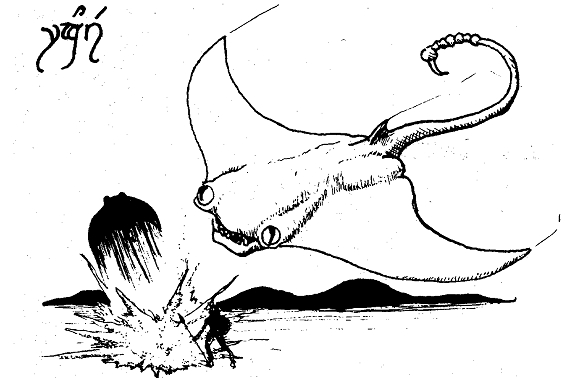
FREQUENCY: Rare
NUMBER APPEARING: 1
ARMOR CLASS: 5 (2)
MOVE: 6” (24”)
HIT DICE: 5 + 1
% IN LAIR: 90%
TREASURE TYPE: See below
NO. OF ATTACKS: 1 or 1
DAMAGE/ATTACK: 2-8 or 1-
3
SPECIAL ATTACKS: Sting;
Surprise on 1-5
SPECIAL DEFENSES: See
below
MAGIC RESISTANCE:
Standard
INTELLIGENCE: Animal
ALIGNMENT: Neutral
SIZE: M (6 1/2’ long)
PSIONIC ABILITY: Nil
Attack/Defense Modes: Nil
MONSTER LEVEL: VI
EXPERIENCE VALUE:
400 + 6/hit point
Sandbats are manta ray-like
creatures found only in desert regions,
large seashores, and other
sandy areas. A sandbat will lie buried just
beneath the sand with only
its raised, frog-like eyes sticking out until
someone walks within ten
to twenty feet of it. Then the creature will
strike suddenly, shooting
up out of the sand (spraying grit in its
victim’s eyes 20% of the
time, thus blinding him for 1-2 melee rounds)
and surprising opponents
on 1-5 on a six-sided die.
Though these beasts can
glide only 6” per turn normally (and then
only for short distances),
they travel at up to 24” per turn when first
striking (and so are armor
class 2 instead of 5 on the first round). In
fact; they move-so quickly
and silently that only a person with Dexterity of 17 or 18 has even a small
chance of ducking out of their way
even If he is not surprised
(25% chance with Dexterity of 17; 40%
with Dexterity of 18). If
the person is surprised, the creature will attack
him with one free round,
and the victim gets no Dexterity defense
bonus on that round.
A sandbat will always bite
for 2-8 points of damage when it first
strikes, but thereafter
there is a 50% chance each round that it will use
the stinger on the. end
of its snaky tail instead. This sting does 1-3
points of damage when it
hits, and will paralyze the opponent on the
next round if he does not
make his saving throw versus paralyzation.
This paralysis lasts for
30 rounds minus the victim’s Constitution
score, In addition, the
victim will lose 4 strength points when the
paralysis wears off, gained
back at a rate of 1 per turn thereafter. Once
the sandbat has paralyzed
one opponent, it will attempt to drag him
into its lair under the
sand to devour him (it must score a hit with its
mouth to do so, but it will
only use its mouth on an already-paralyzed
opponent and it receives
plus 4 hit probability to hit such a victim, in
addition to the loss of
the victim’s Dexterity defense bonus). Only a
direct, damaging hit on
the creature will prevent it from dragging off a
victim, and it will usually
(70%) ignore attackers in its attempt to drag
off the victim
If hard pressed (down to
5 or fewer hit points or greatly outnumbered), a sandbat will attempt to
escape by diving into the sand
and blowing up a thick cloud
of grit behind it (effectively blinding
would-be chasers for 1-6
rounds).
A sandbat will typically
have only types J and K treasure scattered
about its lair under the
sand (from previous victims) with a slight
chance (15%) of having a
larger hoard (types L, M, and Q added).
However, its stomach or
gizzard will often (70%) contain 1-6 gems
(which it uses to help digest
its food).
Description: As mentioned
previously, sandbats look rather like
large, khaki-colored manta
rays, with jutting eyes like those of a frog
and huge maws full of dagger-like
teeth. They have flexible skin
“wings” and long, whip-like
tails with scorpion-type stingers.
Swampbats
Swampbats are distantly
related to sandbats, and, as such, have
many of the same attributes.
However, swampbats (as their name implies) live principally in dark, marshy
areas where they float on the
surface of the water, looking
rather like large plants (lily pads), until
someone gets close enough
for them to strike, when they will lash out
as does a sandbat. Though
these creatures do not have stingers like
their cousins, their maws
are larger and are lined with hundreds of
tiny, needle-like teeth
(rather like that of a leech). When a swampbat
scores a hit, it injects
a poison into the victim which will anesthetize
him for 1-4 normal turns
unless he makes his saving throw versus
paralysis, in addition to
doing the usual 2-8 points of damage. The bat
will then cling to its victim
with hook-like fangs and drain his blood at a
rate of 5 points per round,
up to a maximum amount equalling the
creature’s original hit
points or until the victim is killed.
Of course, swampbats cannot
spray sand behind them as do sandbats, but they can dive underwater if
hard pressed (they have gills),
and can swim at 9” per turn.
They can glide, as do sandbats, at 6” per
turn (24” on the first striking
round), but only for a maximum of 2
turns.
Swampbats do not have any
lair treasure except type Q (20% of
the time), which will be
hidden under nearby rocks (underwater) for
storage, but they have the
usual sandbat treasure in their gizzards.
Except for the information
noted here and for the fact that 1-4
swampbats will be in any
given area, these creatures are treated exactly like sandbats.
Description: Swampbats appear
much the same as sandbats but are
dark green in color with
pale green and blue splotches. They have no
stingers on the end of their
snaky tails, but their maws are round and
full of hundreds of tiny,
needle-like teeth.
NOTE: The referee may rule
that anyone who is near a swampbat
or sandbat (but not close
enough for it to strike) has a 10% chance per
turn of noticing its eyes
(double this if searching). This chance is increased by 10% at night or
in darkness because the eyes glow
(though it will be harder
to tell what they are).
| Dragon | - | Monsters | - | Dragon 42 |